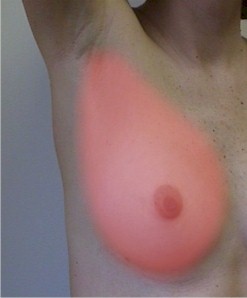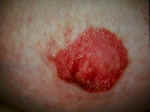|
Breast Development At puberty, the female breast
develops, under the influence of estrogen, progesterone, growth
hormone, prolactin, insulin and probably thyroid hormone, parathyroid
hormone and cortisol. This complex process typically begins between
ages 8 to 14 and spans about 4 years.
The breast contains mostly fat tissue, connective tissue, and
glands that following pregnancy, will produce milk. The milk is
collected in the ducts and transported to 15-25 openings through the
nipple.
During the menstrual cycle, the breast is smallest on days 4-7, and
then begins to enlarge, under the influence of estrogen and later
progesterone and prolactin.
Maximum breast size occurs just prior to the onset of menses.
The breast is not round, but has a "tail" of breast tissue
extending up into the axilla (or armpit).
This is clinically significant because abnormalities can arise
there just as they can in other areas of the breast. During breast
examinations, this area should be palpated.
|
 Supernumerary Breasts
Supernumerary breasts are relatively common. They are found along
the "milk line," extending from the axilla to the groin.
Most of them are not noticed clinically until pregnancy occurs.
Then, under the influence of the pregnancy hormones, the breasts
enlarge in preparation for lactation. It is at this time that soft
swellings along the milk line occur, representing supernumerary
breasts. During lactation, the extra breasts may produce milk.
Although this image shows a supernumerary breast low in the
abdomen, the two most common places for them are in the axilla and
directly underneath the normal breast.
These are not dangerous and are generally ignored. If they prove to
be a cosmetic problem, they can be removed surgically.
Supernumerary Nipples
More common than supernumerary breasts are supernumerary nipples.
Like extra breasts, these are located in the milk line and are not
dangerous.
Unless they are large, they are usually not noticed until a
pregnancy. At that time, like the normal nipples, they enlarge and
darken.
Inverted Nipples
Usually nipples point outward. Sometimes, they invert. When they
persistently point inwards, they are called inverted nipples. This can
be unilateral or bilateral.
With stimulation and nipple erection, most inverted nipples will
evert. Occasionally, they remain inverted despite all efforts to evert
them.
Other than for cosmetics, nipple inversion is not usually a
problem. For breast-feeding, most inverted nipples will evert. Even
those that do not evert may still function normally enough to allow
for satisfactory infant nursing.
Adolescent Breast
Problems
There is considerable individual
variation in age at which this development occurs.
Asymmetrical breast growth during
adolescence is the rule rather than the exception. Reassurance is
given that the asymmetry usually evens out by the time of full
maturation.
Mammary hypertrophy can be a
distressing symptom. Because growth and development continues for a
long time, surgical intervention, if contemplated is postponed until
the breasts are fully mature.
Breast masses in adolescents are
essentially 100% benign. Because of this, surgery (excisional biopsy
or fine needle aspiration) is almost never warranted. Further, the
surgical disruption of architecture can be disfiguring as the breast
continues to mature.
Pregnancy Changes
During pregnancy, a number of
changes occur over time which prepare the breast for lactation. These
images demonstrate these changes:
-
Early in the first trimester, the
breasts and nipples become tender. The tenderness persists until the
end of the 1st trimester, at which time the tenderness disappears.
-
By the end of the first
trimester, enlargement of the breast and nipple is noticeable.
-
By the third trimester, the
breast and nipple have experienced further enlargement and the
Montgomery's glands around the periphery of the areola become more
pronounced.
-
The nipples gradually darken,
becoming dark brown or black by full term.
Continue
to the PowerPoint Lecture...
From:
Operational Obstetrics & Gynecology
2nd Edition
NAVMEDPUB 6300-2C
Bureau of Medicine and Surgery
Department of the Navy |


